*NURSING > QUESTIONS & ANSWERS > Physical Examination & Health Assessment, 6th Edition Chapter 04: The Complete Health History (All)
Physical Examination & Health Assessment, 6th Edition Chapter 04: The Complete Health History
Document Content and Description Below
Physical Examination & Health Assessment, 6th Edition Chapter 04: The Complete Health History Test Bank MULTIPLE CHOICE 1. The nurse is preparing to conduct a health history. Which of the... se statements best describes the purpose of a health history? A. To provide an opportunity for interaction between patient and nurse B. To provide a form for obtaining the patient’s biographic information C. To document the normal and abnormal findings of a physical assessment D. To provide a data base of subjective information about the patient’s past and current health 2. When the nurse is evaluating the reliability of a patient’s responses, which of these statements would be correct? The patient: A. has a history of drug abuse and therefore is not reliable. B. provided consistent information and therefore is reliable. C. smiled throughout interview and therefore is assumed reliable. D. would not answer questions concerning stress and therefore is not reliable. 3. A 59-year-old patient tells the nurse that he has ulcerative colitis. He has been having “black stools” for the last 24 hours. How would the nurse best document his reason for seeking care? A. J. M. is a 59-year-old male here for “ulcerative colitis.” B. J. M. came into the clinic complaining of black stools for the past 24 hours. C. J. M., a 59-year-old male, states he has ulcerative colitis and wants it checked. D. J. M. is a 59-year-old male here for having “black stools” for the past 24 hours. 4. A patient tells the nurse that she has had abdominal pain for the past week. What would be the best response by the nurse? A. “Can you point to where it hurts?” B. “We’ll talk more about that later in the interview.” C. “What have you had to eat in the last 24 hours?” D. “Have you ever had any surgeries on your abdomen?” 5. A 29-year-old woman tells the nurse that she has “excruciating pain” in her back. Which would be an appropriate response by the nurse to the woman’s statement? A. “How does your family react to your pain?” B. “That must be terrible. You probably pinched a nerve.” C. “I’ve had back pain myself, and it can be excruciating.” D. “How would you say the pain affects your ability to do your daily activities?” 6. In recording the childhood illnesses of a patient who denies having had any, which note by the nurse would be most accurate? A. Patient denies usual childhood illnesses. B. Patient states he was a “very healthy” child. C. Patient states sister had measles, but he didn’t. D. Patient denies measles, mumps, rubella, chickenpox, pertussis, and strep throat. 7. A female patient tells the nurse that she has had six pregnancies, with four live births at term and two spontaneous abortions. Her four children are still living. How would the nurse record this information? A. P-6, B-4, (S)Ab-2 B. Grav 6, Term 4, (S)Ab-2, Living 4 C. Patient has had four living babies. D. Patient has been pregnant six times. 8. A patient tells the nurse that he is allergic to penicillin. What would be the nurse’s best response to this information? A. “Are you allergic to any other drugs?” B. “How often have you received penicillin?” C. “I’ll write your allergy on your chart so you won’t receive any penicillin.” D. “Please describe what happens to you when you take penicillin.” 9. The nurse is taking a family history. Important diseases or problems to ask the patient about specifically include: A. emphysema. B. head trauma. C. mental illness. D. fractured bones. 10. The review of systems provides the nurse with: A. physical findings related to each system. B. information regarding health promotion practices. C. an opportunity to teach the patient medical terms. D. information necessary for the nurse to diagnose the patient’s medical problem. 11. Which of these statements represents subjective data the nurse obtained from the patient regarding the patient’s skin? A. Skin appears dry. B. No obvious lesions. C. Denies color change. D. Lesion noted lateral aspect right arm. 12. The nurse is obtaining a history from a 30-year-old male patient and is concerned about health promotion activities. Which of these questions would be appropriate to use to assess health promotion activities for this patient? A. “Do you perform testicular self-examinations?” B. “Have you ever noticed any pain in your testicles?” C. “Have you had any problems with passing urine?” D. “Do you have any history of sexually transmitted disease?” 13. Which of these responses might the nurse expect during a functional assessment of a patient whose leg is in a cast? A. “I broke my right leg in a car accident 2 weeks ago.” B. “The pain is decreasing, but I still need to take acetaminophen.” C. “I check the color of my toes every evening just like I was taught.” D. “I’m able to transfer myself from the wheelchair to the bed without help.” 14. In response to a question about stress, a 39-year-old woman tells the nurse that her husband and mother both died in the past year. Which response by the nurse is most appropriate? A. “This has been a difficult year for you.” B. “I don’t know how anyone could handle that much stress in one year!” C. “What did you do to cope with the loss of both your husband and mother?” D. “That is a lot of stress; now let’s go on to the next section of your history.” 15. In response to a question regarding use of alcohol, a patient asks the nurse why the nurse needs to know. What is the reason for needing this information? A. This information is necessary to determine the patient’s reliability. B. Alcohol can interact with all medications and can make some diseases worse. C. The nurse needs to be able to teach the patient about the dangers of alcohol use. D. It’s not really necessary to have this information unless there is an obvious drinking problem. 16. The mother of a 16-month-old toddler tells the nurse that her daughter has an earache. What would be an appropriate response? A. “Maybe she is just teething.” B. “I will check her ear for an ear infection.” C. “Are you sure she is really having pain?” D. “Please describe what she is doing to indicate she is having pain.” 17. During an assessment of a patient’s family history, the nurse constructs a genogram. Which statement best describes a genogram? A. A list of diseases present in a person’s near relatives B. A graphic family tree that uses symbols to depict the gender, relationship, and age of immediate family members C. A drawing that depicts the patient’s family members up to five generations back D. A description of the health of a person’s children and grandchildren 18. A 5-year-old boy is being admitted to the hospital to have his tonsils removed. Which information should the nurse collect before this procedure? A. The child’s birth weight B. The age at which he crawled C. Whether he has had the measles D. Reactions to previous hospitalizations 19. As part of the health history of a 6-year-old boy at a clinic for a sports physical, the nurse reviews his immunization record and notes that his last MMR (measles-mumps-rubella) vaccination was at 15 months of age. What recommendation should the nurse make? A. No further MMR immunizations are needed. B. MMR needs to be repeated at 4 to 6 years of age. C. MMR needs to be repeated every 4 years until age 21. D. A recommendation cannot be made until physician is consulted. 20. In obtaining a review of systems on a “healthy” 7-year-old girl, the health care provider knows that it would be important to include the: A. last glaucoma examination. B. frequency of breast self-examinations. C. date of her last electrocardiogram. D. limitations related to her involvement in sports activities. 21. When the nurse asks for a description of who lives with a child, the method of discipline, and support system of the child, what part of the assessment is being performed? A. Family history B. Review of systems C. Functional assessment D. Reason for seeking care 22. The nurse is obtaining a health history on an 87-year-old woman. Which of the following areas of questioning would be most useful at this time? A. Obstetric history B. Childhood illnesses C. General health for the past 20 years D. Current health promotion activities 23. The nurse is performing a review of systems on a 76-year-old patient. Which of these statements is correct for this situation? A. The questions asked are identical for all ages. B. The interviewer will start incorporating different questions for patients 70 years of age and older. C. Additional questions to include are reflective of the normal effects of aging. D. At this age, a review of systems is not necessary—the focus should be on current problems. 24. A 90-year-old patient tells the nurse that he can’t remember the names of the medications he is taking or for what reason he is taking them. An appropriate response from the nurse would be: A. “Can you tell me what they look like?” B. “Don’t worry about it. You are only taking two medications.” C. “How long have you been taking each of the pills?” D. “Would you have your family bring in your medications?” 25. The nurse is performing a functional assessment on an 82-year-old patient who recently had a stroke. Which of these questions would be most important to ask? A. “Do you wear glasses?” B. “Are you able to dress yourself?” C. “Do you have any thyroid problems?” D. “How many times a day do you have a bowel movement?” 26. The nurse is preparing to do a functional assessment. Which statement best describes the purpose of a functional assessment? A. It assesses how the individual is coping with life at home. B. It determines how children are meeting developmental milestones. C. It can identify any problems with memory the individual may be experiencing. D. It helps to determine how a person is managing day-to-day activities. 27. The nurse is asking a patient for his reason for seeking care, and asks about the signs and symptoms he is experiencing. Which of these is an example of a symptom? A. Chest pain B. Clammy skin C. Serum potassium level 4.2 mEq/L D. A temperature of 100° F 28. A patient is describing his symptoms to the nurse. Which of these statements reflects a description of the setting of his symptoms? A. “It is a sharp, burning pain in my stomach.” B. “I also have the sweats and nausea when I feel this pain.” C. “I think this pain is telling me that something bad is wrong with me.” D. “This pain happens every time I sit down to use the computer.” 29. During an assessment, the nurse uses the CAGE test. The patient answers “yes” to two of the questions. What could this be indicating? A. The patient is an alcoholic. B. The patient is annoyed at the questions. C. The patient should be examined thoroughly for possible alcohol withdrawal symptoms. D. The nurse should suspect alcohol abuse and continue with a more thorough substance abuse assessment. 30. The nurse is performing a review of symptoms. Which of these questions are appropriate as health promotion questions to ask during this time? A. “Do you use sunscreen while outside?” B. “May I see if your skin is warm and dry?” C. “Have you had any dizziness or headaches?” D. “When you cough, what color is the sputum you bring up?” 31. The nurse is incorporating a person’s spiritual values into the health history. Which of these questions illustrates the “community” portion of the FICA questions? A. “Do you believe in God?” B. “Are you a part of any religious or spiritual congregation?” C. “Do you consider yourself to be a religious or spiritual person?” D. “How does your religious faith influence the way you think about your health?” 32. The nurse is preparing to complete a health assessment on a 16-year-old girl whose parents have brought her to the clinic. Which instruction would be appropriate for the parents before the interview begins? A. “Please stay during the interview; you can answer for her if she does not know the answer.” B. “It would help to interview the three of you together.” C. “While I interview your daughter, will you please stay in the room and complete these family health history questionnaires?” D. “While I interview your daughter, will you step out to the waiting room and complete these family health history questionnaires?” 33. The nurse is assessing a new patient who has recently immigrated to the United States. Which question is appropriate to add to the health history? A. “Why did you come to the United States?” B. “When did you come to the United States, and from what country?” C. “What made you leave your native country?” D. “Are you planning to return to your home?” MULTIPLE RESPONSE 1. The nurse is assessing a patient’s headache pain. Which questions reflect one or more of the critical characteristics of symptoms that should be assessed? Select all that apply. A. “Where is the headache pain?” B. “Did you have these headaches as a child?” C. “On a scale of 1 to 10, how bad is the pain?” D. “How often do the headaches occur?” E. “What makes the headaches feel better?” F. “Do you have any family history of headaches?” 2. The nurse is conducting a developmental history on a 5-year-old child. Which questions are appropriate to ask the parents for this part of the assessment? Select all that apply. A. “How much junk food does your child eat?” B. “How many teeth has he lost, and when did he lose them?” C. “Is he able to tie his shoelaces?” D. “Does he take a children’s vitamin?” E. “Can he tell time?” F. “Does he have any food allergies?” [Show More]
Last updated: 2 years ago
Preview 1 out of 8 pages

Buy this document to get the full access instantly
Instant Download Access after purchase
Buy NowInstant download
We Accept:

Reviews( 0 )
$15.00
Can't find what you want? Try our AI powered Search
Document information
Connected school, study & course
About the document
Uploaded On
Apr 19, 2020
Number of pages
8
Written in
Additional information
This document has been written for:
Uploaded
Apr 19, 2020
Downloads
0
Views
98

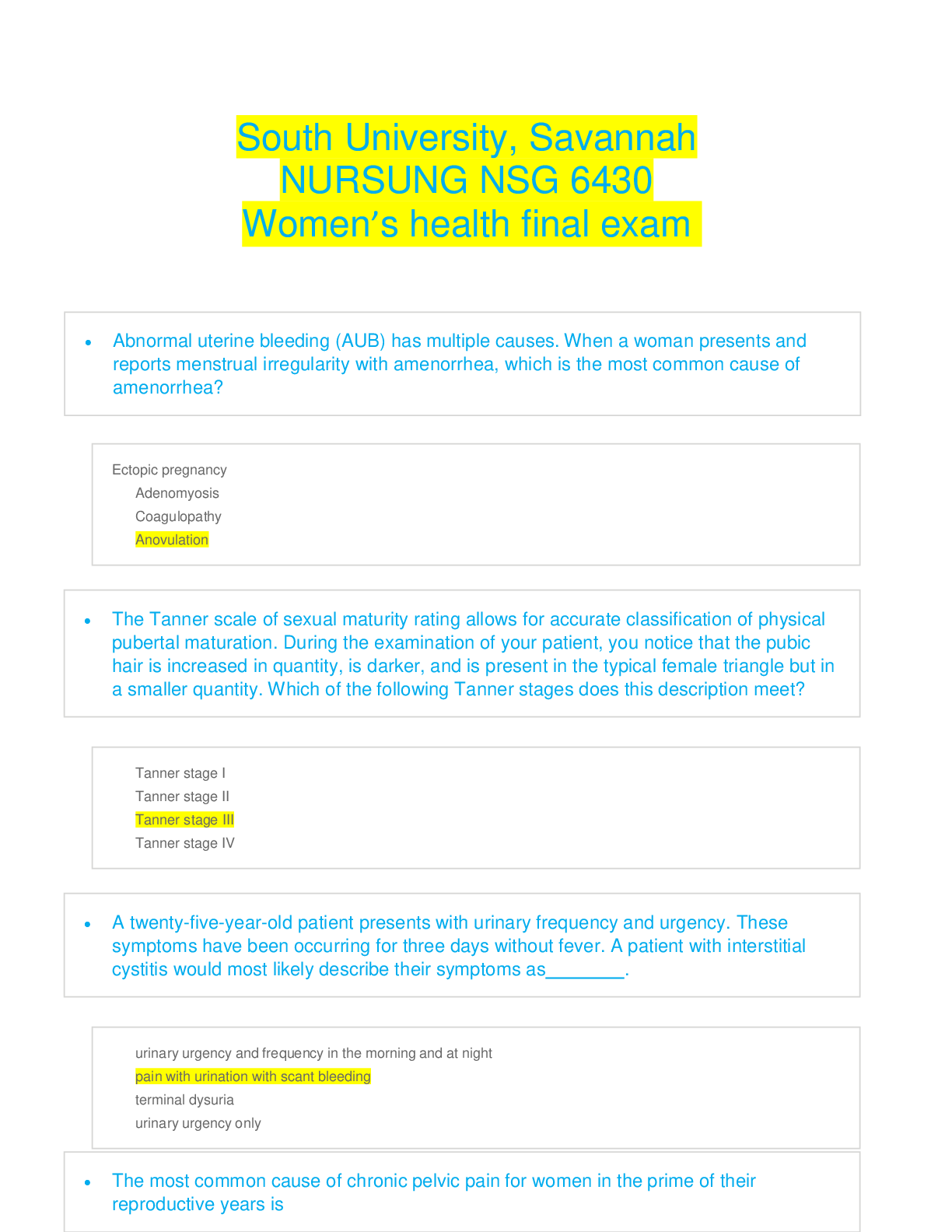

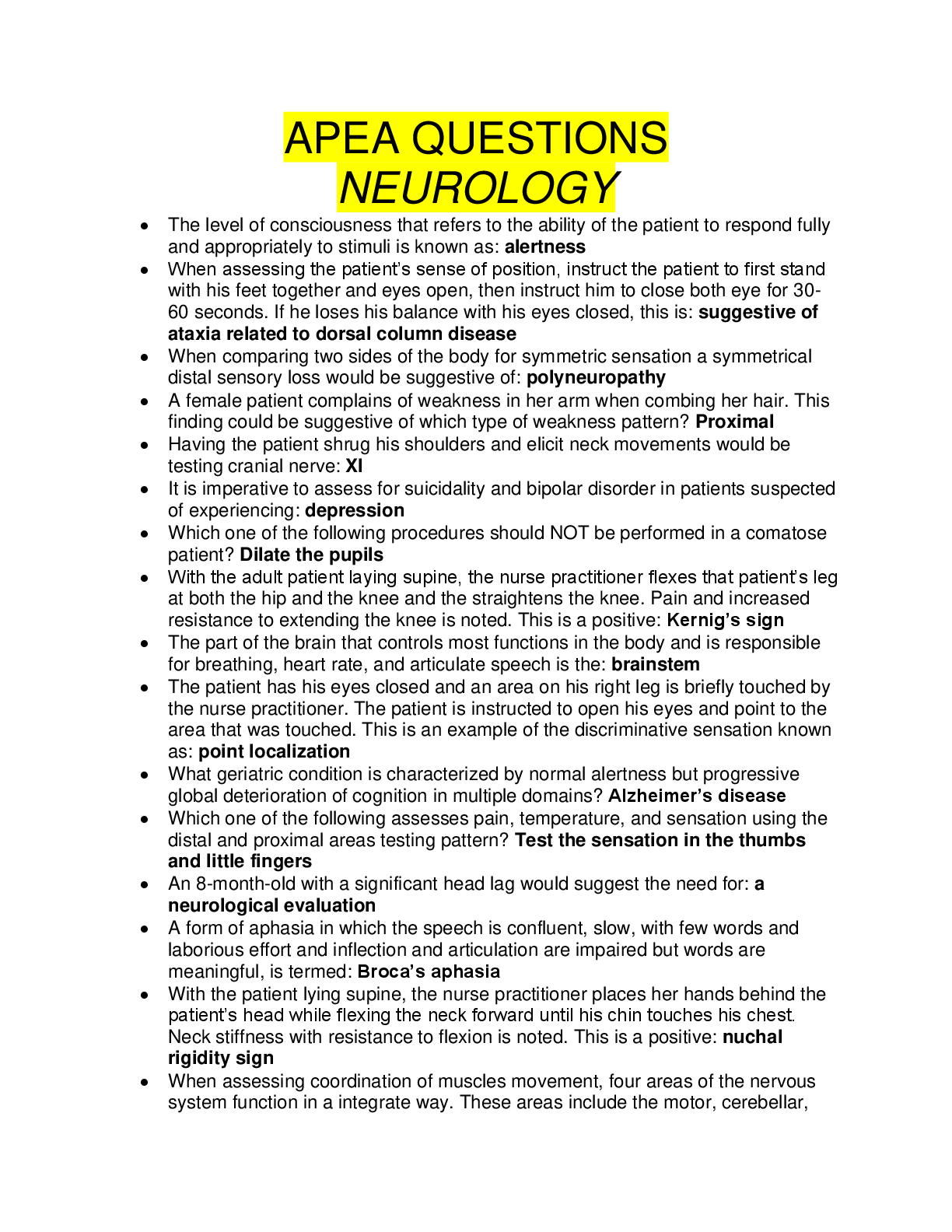

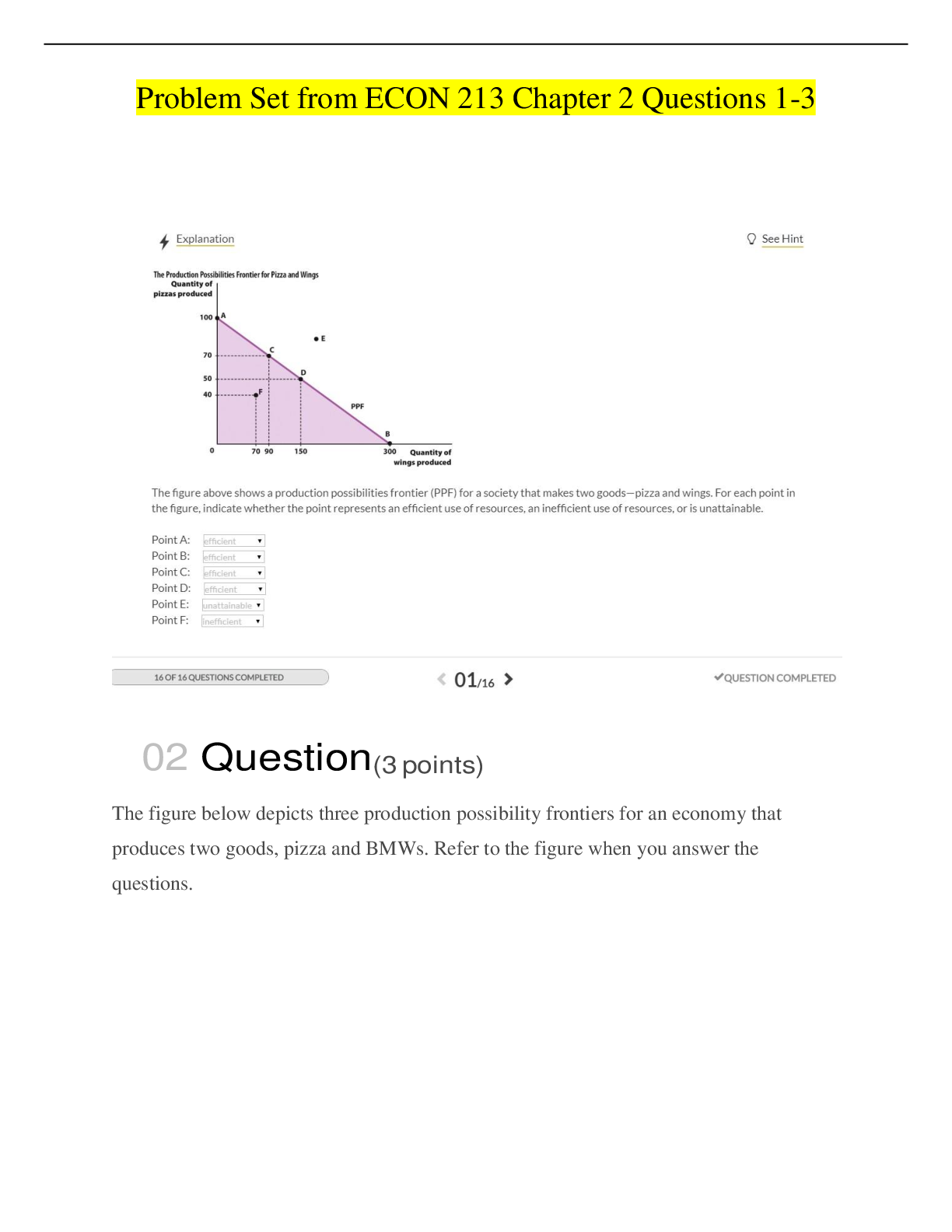
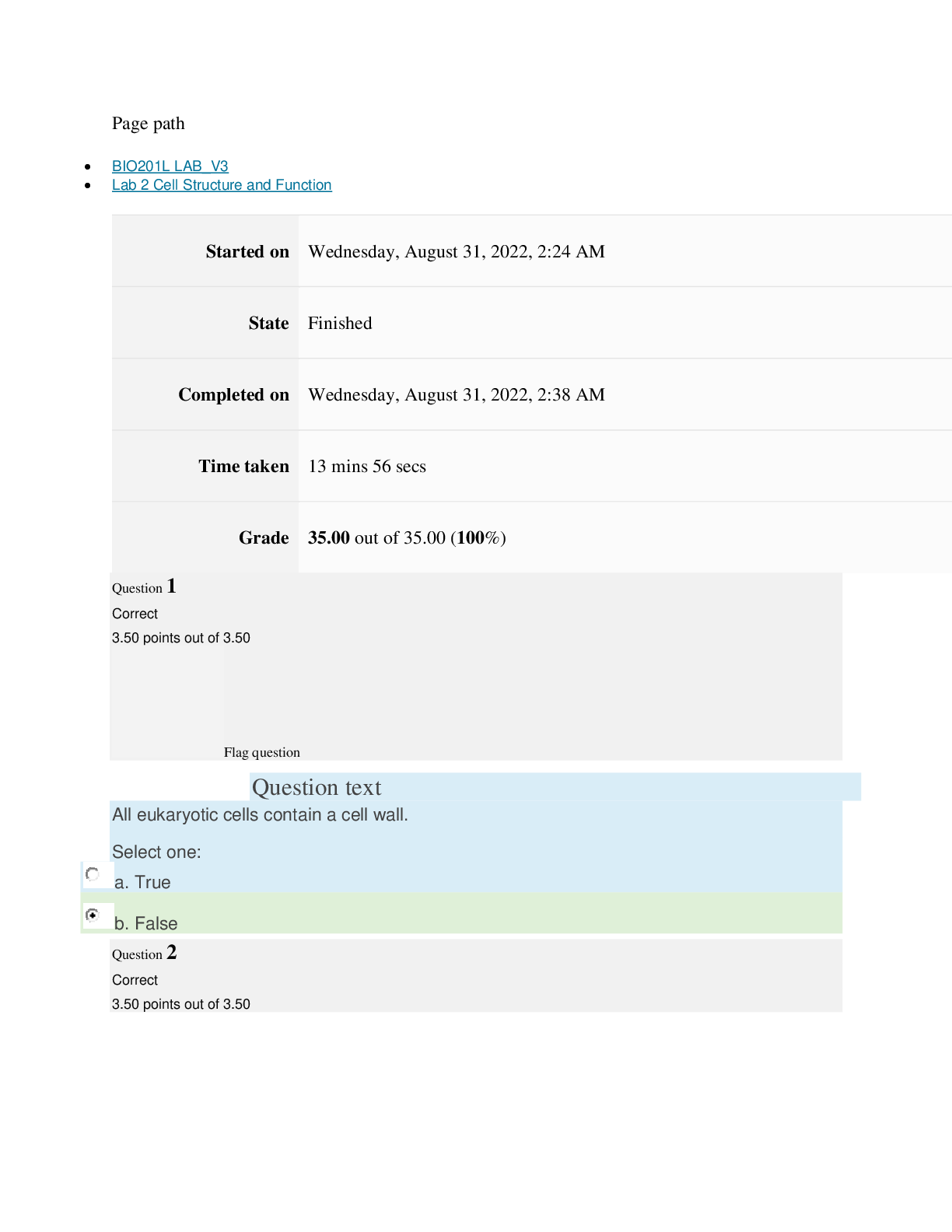

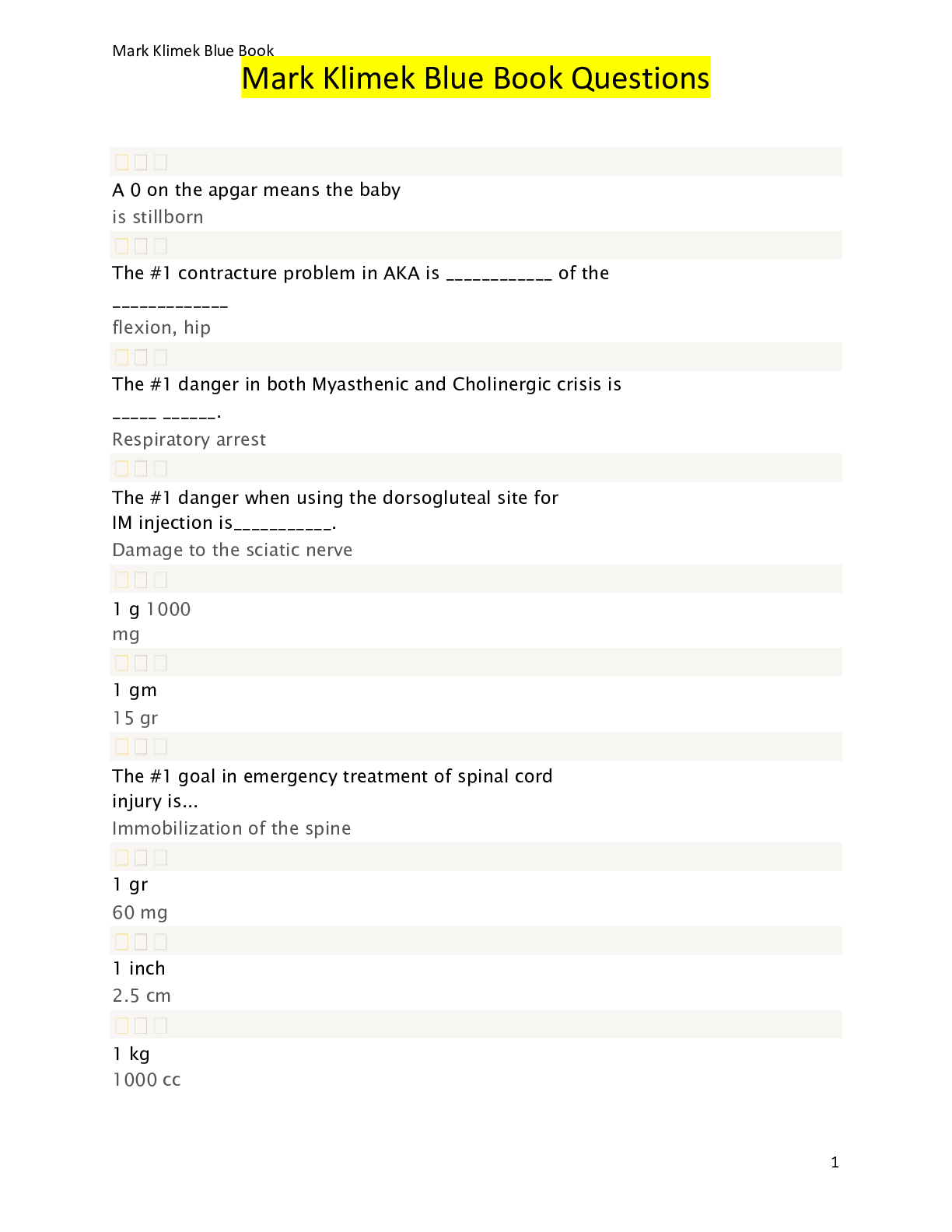

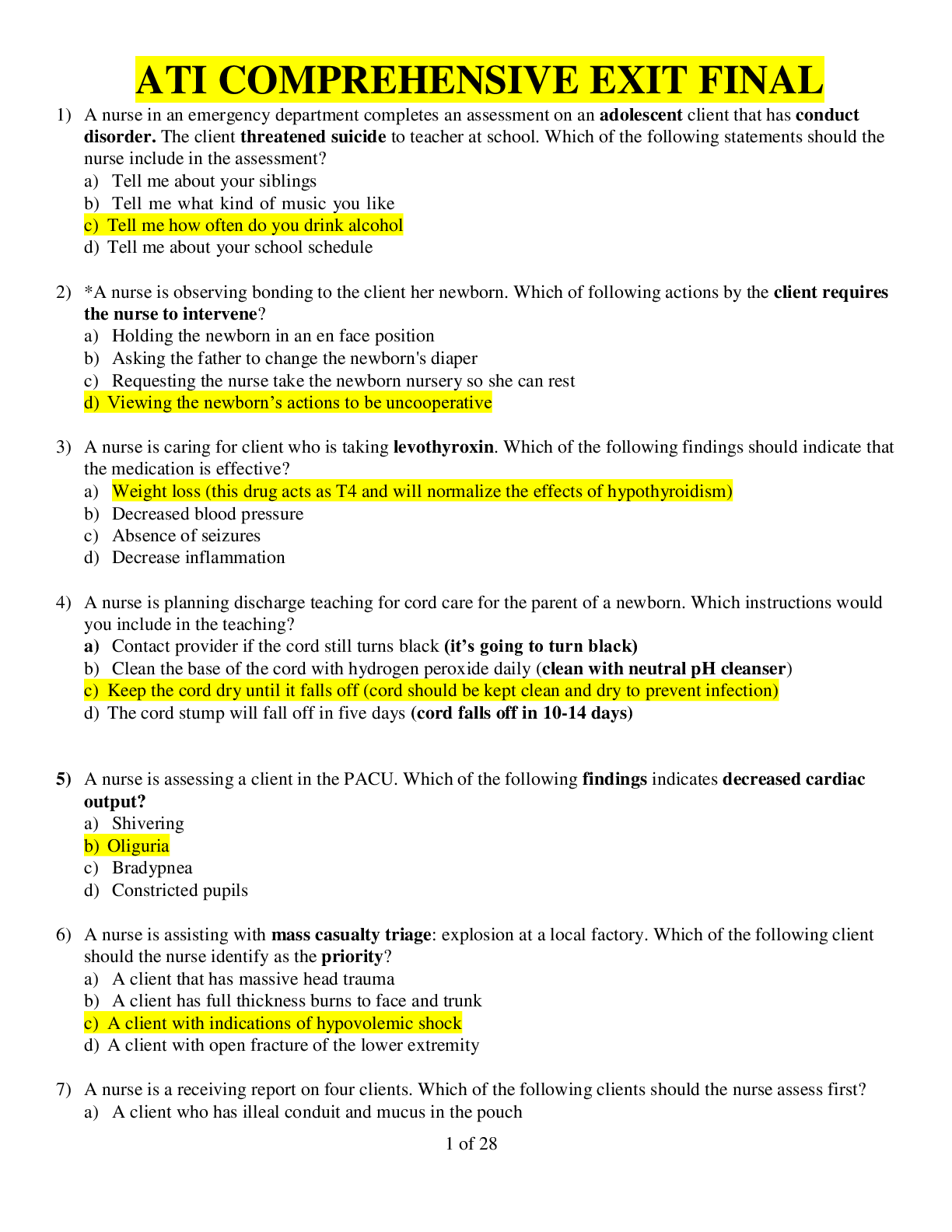

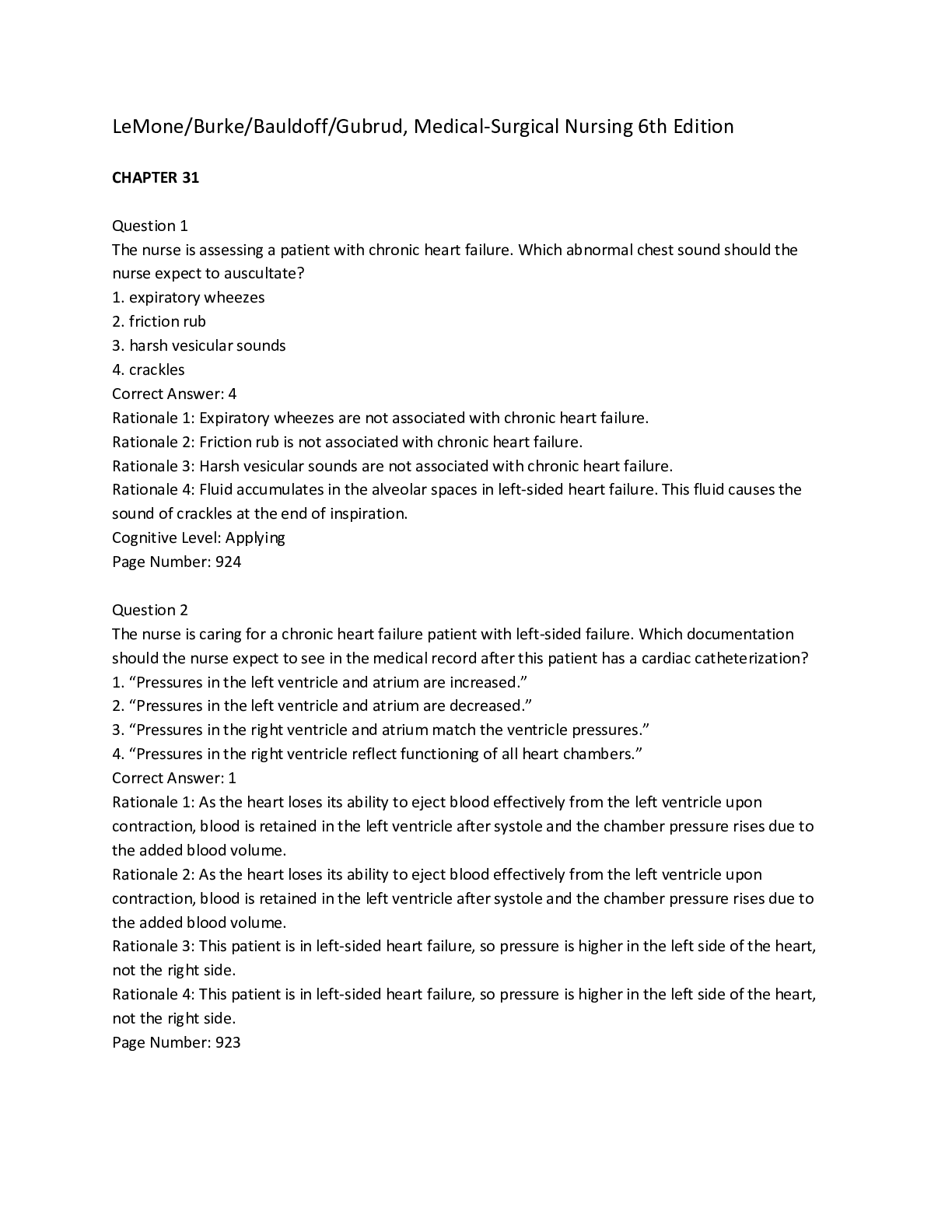
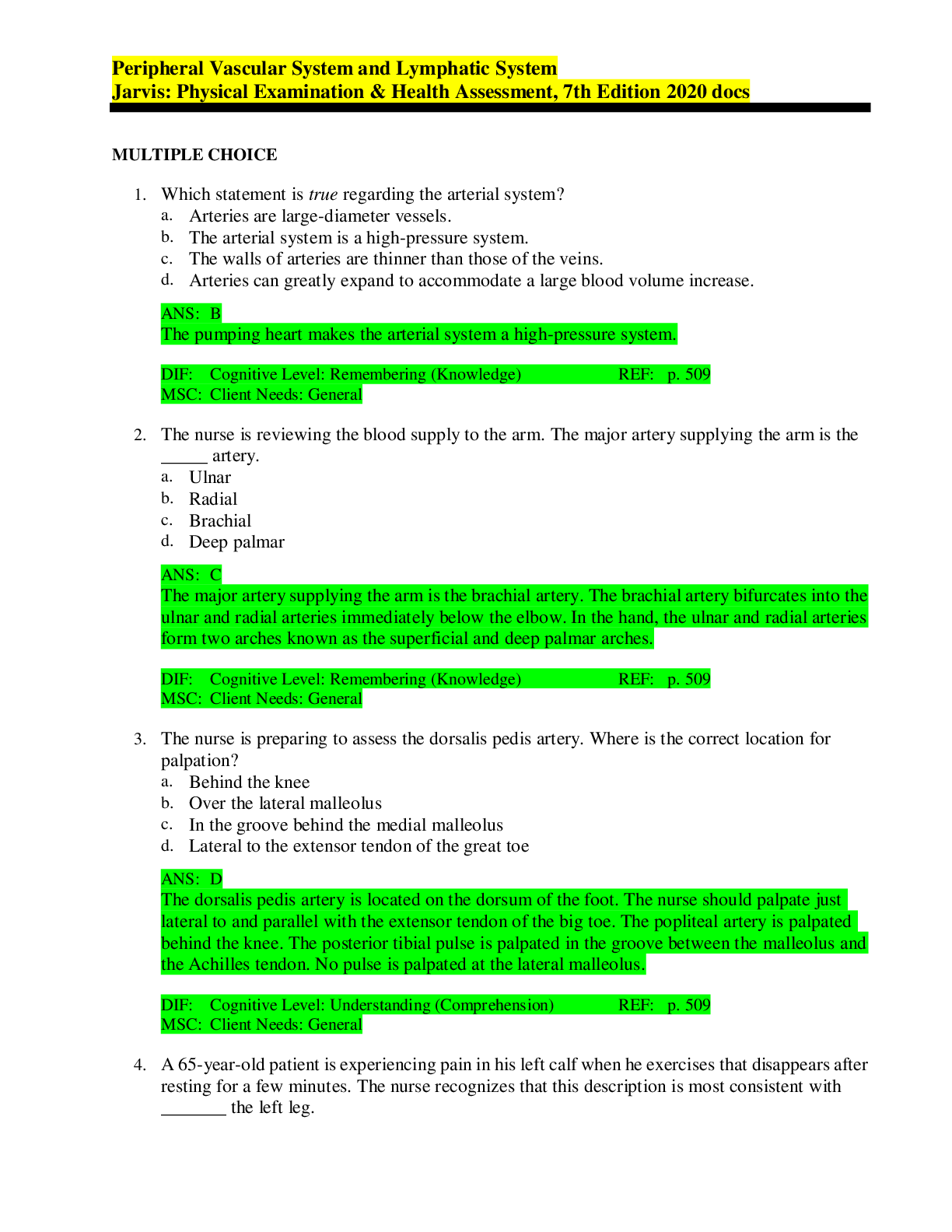
 answers.png)

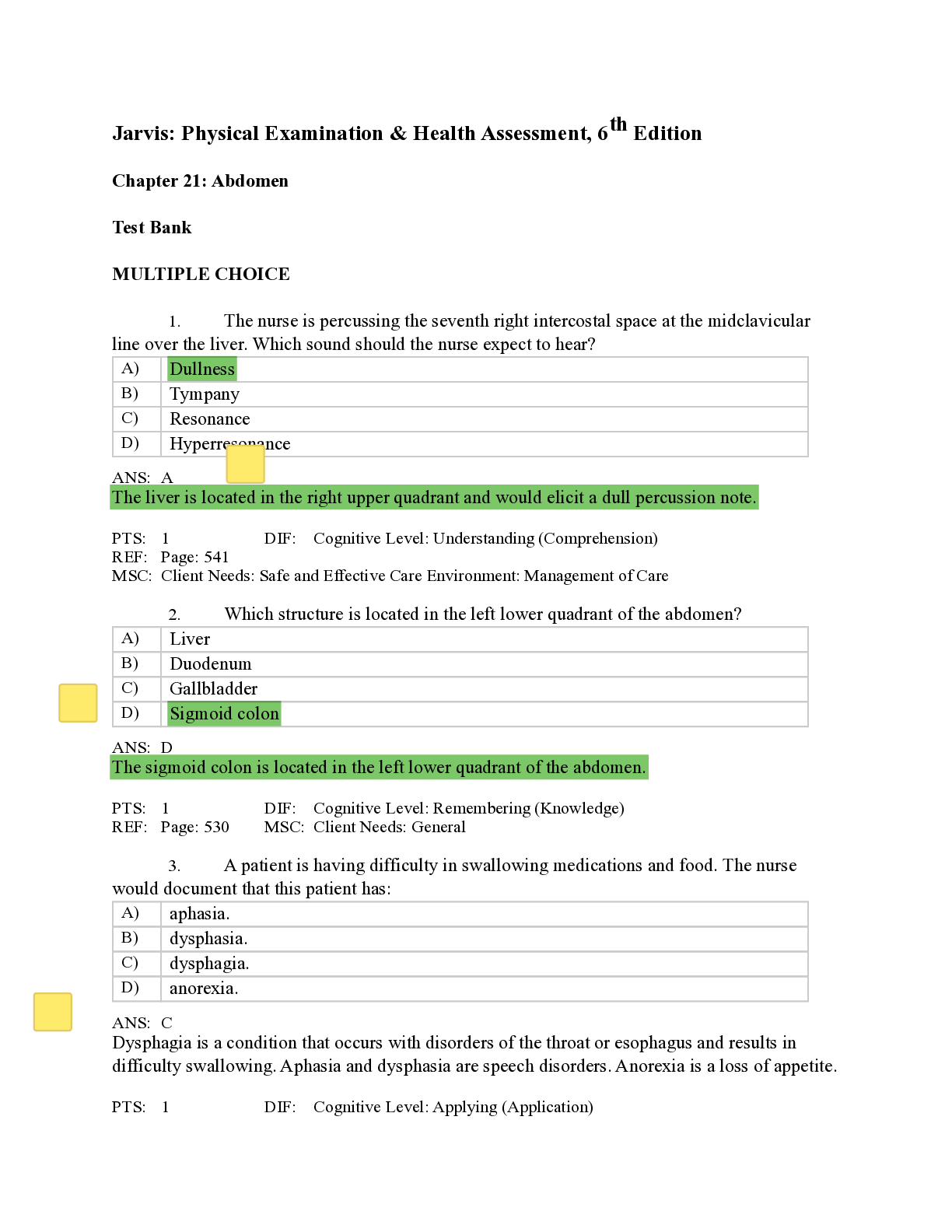
, Latest Questions and Answers with Explanations for Revision, All C.png)
, Latest Questions and Answers with Explanations for Revision, All Correct Latest Review, (La.png)
, Latest Questions and Answers with Explanations for Revision, All Correct Latest Review, (Latest 2021) Correc.png)
, Latest Questions and Answers with Explanations for Revision, All Correct Latest Revie.png)


